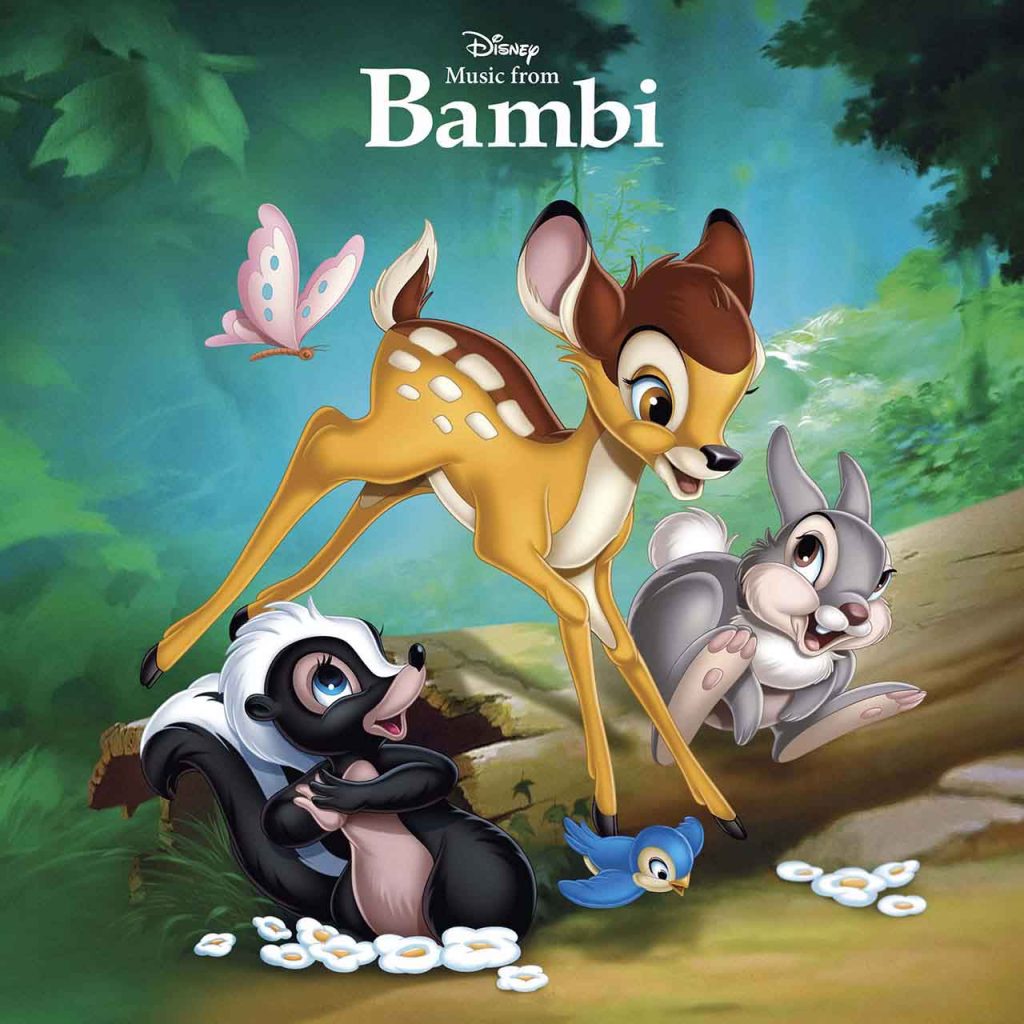Walt Disney’s fifth animated feature film, Bambi, has touched the hearts of generations of children since its release in 1942. The story of a young deer’s coming of age, it’s continued to resonate thanks to its stunning animation, enchanting soundtrack, and universal themes. Birth, struggle, grief, the changing of the seasons – Bambi is the cycle of life brought to the silver screen. The music follows suit.
At the time of its release, Bambi represented another rewriting of the rulebook from Disney. Their first animated feature, Snow White & The Seven Dwarfs (1937), was a massive leap forward in terms of sophistication and the following films had left audiences similarly gobsmacked, particularly the musical wonder of Fantasia (1939).
Listen to Bambi on Spotify or Apple Music now.
Realizing that an animated film focusing solely on animals required a new level of realism and visual poetry, Walt Disney used innovative techniques to ensure his animators were up to speed. He arranged for the celebrated Italian artist Rico Lebrun to teach classes on the physiology and movement of animals at the studio. Animators visited Los Angeles Zoo to study their subjects up close. Walt even set up a small zoo – with fawns, rabbits, ducks, owls, and skunks – at the animation studio. Similar attention was paid to the backgrounds, with artists going on field trips to the Vermont and Maine forests. Animator Tyrus Wong’s lush and impressionistic take on the woodland landscapes provided a blueprint for the film’s scenery.
Just as much care was taken with Bambi’s soundtrack. Dialogue is used sparingly in the film and music is a near-constant, the pastoral symphony scored by Frank Churchill and Edward Plumb giving voice to nature as a character. The score stops just twice, both times with great impact, as Disney producer Don Hahn suggests in the 1994 documentary, The Making Of Bambi: A Prince Is Born, “I think Walt realized that music was going to have to play an exceptional role in Bambi because the music is so minimal. From the beginning to the end of Bambi, there’s barely a moment that doesn’t use music – the only two gaps are at crucial points in the story. The first is when Bambi’s mother says, “Man… was in the forest” – [the] other time is after Bambi’s mother dies.”
Little April Shower (From “Bambi”https://www.udiscovermusic.com/Soundtrack Version)
Click to load video
The emotional heavy lifting and sensitivity required of the score was another challenge, ably met by Churchill and Plumb. Frank Churchill was the main composer; he wrote musical themes and motifs that were taken and arranged into the final score. Churchill had enjoyed huge success with his soundtrack to Snow White & The Seven Dwarfs, featuring the classics “Heigh-Ho” and “Whistle While You Work.” He had also written “Who’s Afraid Of The Big Bad Wolf” from the 1933 animated short, Three Little Pigs. Churchill had a talent for writing melodies so simple and memorable they felt timeless; as if they were folk songs rather than newly written for groundbreaking animated films. Churchill’s training was in soundtracking silent films, and he was a skilled improviser, which made him the perfect candidate for Bambi. The composer’s knack for flourishes to complement scenes in which Bambi faltered on her feet, or Thumper showed his rambunctious side added an extra dimension to the characters.
Edward Plumb provided a counterpoint to Churchill’s intuitive melodic genius. Plumb is said to have studied with Johann Strauss and brought a classically trained sophistication to the orchestrations. Plumb had previously been the musical director on Fantasia, an experience that served him well when fleshing out Churchill’s themes into a pastoral symphony.
While Bambi’s immediate commercial fortunes were affected by its release during World War II, it has since become one of the studio’s best-loved feature films. Still, it was celebrated by critics at the time – Bambi earned three Academy Award® nominations, for Best Sound, Best Score, and Best Song. (The latter for “Love is a Song,” sung by Donald Novis).
Main Title (Love Is a Song) (Soundtrack)
Click to load video
It also had an impact on society that went beyond the norm for an animated feature of the time. Bambi is an environmentalist film that depicts mankind as a destructive force, a timely message at the time it was made. Similarly, its influence on generations of animal lovers cannot be overstated. Indeed, Paul McCartney has credited Bambi as the film that made him aware of animal rights – there must have been countless others over the years to be similarly moved.
Bambi was also a huge influence on future animated films, especially Disney’s 1994 epic, The Lion King. In The Making Of Bambi: Prince Is Born Don Hahn explains, “Bambi at its heart is the coming of age story – what happens when we lose our parents? What happens, metaphorically, when we’re kicked out of the nest?… We borrowed from it in big heaped spoonfuls for The Lion King, and happily so.”
Bambi has not only delighted generations of film lovers but can be seen as one of the movies that genuinely shaped the way we think. Not for the first time, Walt Disney’s ambition and creative derring-do had paid off.
Listen to Bambi on Spotify or Apple Music now.



